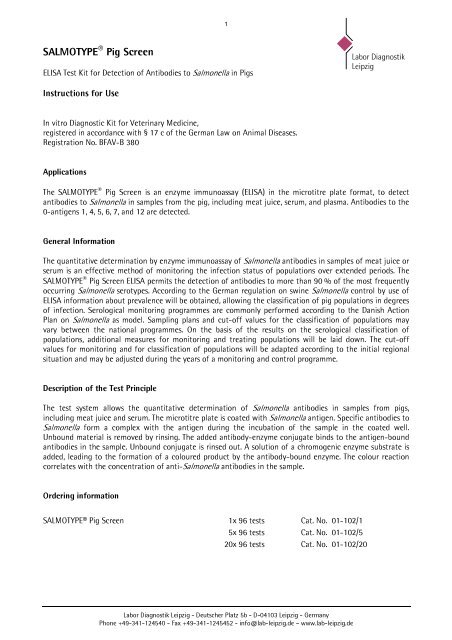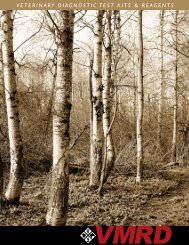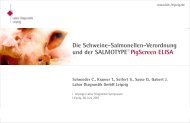SALMOTYPE Pig Screen - Labor Diagnostik GmbH
SALMOTYPE Pig Screen - Labor Diagnostik GmbH
SALMOTYPE Pig Screen - Labor Diagnostik GmbH
You also want an ePaper? Increase the reach of your titles
YUMPU automatically turns print PDFs into web optimized ePapers that Google loves.
<strong>SALMOTYPE</strong> ® <strong>Pig</strong> <strong>Screen</strong><br />
ELISA Test Kit for Detection of Antibodies to Salmonella in <strong>Pig</strong>s<br />
Instructions for Use<br />
In vitro Diagnostic Kit for Veterinary Medicine,<br />
registered in accordance with § 17 c of the German Law on Animal Diseases.<br />
Registration No. BFAV-B 380<br />
Applications<br />
The <strong>SALMOTYPE</strong> ® <strong>Pig</strong> <strong>Screen</strong> is an enzyme immunoassay (ELISA) in the microtitre plate format, to detect<br />
antibodies to Salmonella in samples from the pig, including meat juice, serum, and plasma. Antibodies to the<br />
0-antigens 1, 4, 5, 6, 7, and 12 are detected.<br />
General Information<br />
The quantitative determination by enzyme immunoassay of Salmonella antibodies in samples of meat juice or<br />
serum is an effective method of monitoring the infection status of populations over extended periods. The<br />
<strong>SALMOTYPE</strong> ® <strong>Pig</strong> <strong>Screen</strong> ELISA permits the detection of antibodies to more than 90 % of the most frequently<br />
occurring Salmonella serotypes. According to the German regulation on swine Salmonella control by use of<br />
ELISA information about prevalence will be obtained, allowing the classification of pig populations in degrees<br />
of infection. Serological monitoring programmes are commonly performed according to the Danish Action<br />
Plan on Salmonella as model. Sampling plans and cut-off values for the classification of populations may<br />
vary between the national programmes. On the basis of the results on the serological classification of<br />
populations, additional measures for monitoring and treating populations will be laid down. The cut-off<br />
values for monitoring and for classification of populations will be adapted according to the initial regional<br />
situation and may be adjusted during the years of a monitoring and control programme.<br />
Description of the Test Principle<br />
The test system allows the quantitative determination of Salmonella antibodies in samples from pigs,<br />
including meat juice and serum. The microtitre plate is coated with Salmonella antigen. Specific antibodies to<br />
Salmonella form a complex with the antigen during the incubation of the sample in the coated well.<br />
Unbound material is removed by rinsing. The added antibody-enzyme conjugate binds to the antigen-bound<br />
antibodies in the sample. Unbound conjugate is rinsed out. A solution of a chromogenic enzyme substrate is<br />
added, leading to the formation of a coloured product by the antibody-bound enzyme. The colour reaction<br />
correlates with the concentration of anti-Salmonella antibodies in the sample.<br />
Ordering information<br />
<strong>SALMOTYPE</strong>® <strong>Pig</strong> <strong>Screen</strong> 1x 96 tests Cat. No. 01-102/1<br />
5x 96 tests Cat. No. 01-102/5<br />
20x 96 tests Cat. No. 01-102/20<br />
1<br />
<strong>Labor</strong> <strong>Diagnostik</strong> Leipzig - Deutscher Platz 5b - D-04103 Leipzig - Germany<br />
Phone +49-341-124540 - Fax +49-341-1245452 - info@lab-leipzig.de – www.lab-leipzig.de<br />
<strong>Labor</strong> <strong>Diagnostik</strong><br />
Leipzig
Reagents Amount *<br />
1er Kit 5er Kit 20er Kit<br />
1. Test Plate, contains 12 microtitre strips with 8 wells each or 1<br />
Test Plate, microtitre plate with 96 wells, 5 20<br />
coated with inactivated Salmonella antigen<br />
2. Dilution Buffer, with protein and preservative, ready-to-use 60 ml 2x 125 ml 1.0 l<br />
3. Negative Control, ready-to-use, Salmonella-negative pig serum,<br />
in buffer with protein and preservative 1.5 ml 1.5 ml 2x 3.0 ml<br />
4. Positive Control, ready-to-use, Salmonella-positive pig serum,<br />
in buffer with protein and preservative 1.5 ml 1.5 ml 2x 3.0 ml<br />
5. Wash Buffer (10x), buffer solution with Tween and preservative 125 ml 2x 125 ml 1.0 l<br />
6. Anti-IgG-HRP, ready-to-use,<br />
anti-pig-IgG horseradish peroxidase conjugate in buffer with<br />
protein stabilisers and preservative 12 ml 60 ml 240 ml<br />
7. TMB (Tetramethylbenzidine) Substrate Solution, ready-to-use 12 ml 60 ml 240 ml<br />
8. Stop Solution, 0.5 M sulfuric acid, ready-to-use (caution!) 12 ml 60 ml 240 ml<br />
* The one-plate pack size contains 12 strips each with 8 wells in a frame and desiccant in a re-sealable pack.<br />
Large packages in different configurations are available on request.<br />
Storage and Shelf Life<br />
The kit components are stable until the imprinted date.<br />
Store the reagents at 2-8 °C. Wash Buffer (10x) may be stored at room temperature (18-25 °C) to avoid salt<br />
crystallisation. Also Stop Solution can be stored at room temperature. Store the remaining test strips in the<br />
re-sealed pack with desiccant at 2-8 °C until next use. The test strips can be stored at least for 6 weeks after<br />
opening the plate pack.<br />
Necessary Instruments and Materials Not Included in the Order<br />
Beakers, measuring cylinders, analytical pipettes, multichannel pipettes, disposable pipette tips, pipetting<br />
troughs, microtitre plate spectrophotometer, microtitre plate shaker, tubes or predilution plates for diluting<br />
the samples, distilled water, meat juice container (SALMOSTORE) for isolating meat juice.<br />
Precautions and Warnings<br />
2<br />
The test should only be performed by persons qualified for laboratory work. Bring the reagents to room<br />
temperature (18-25 °C) immediately before use. In case of salt crystallisation in the 10x Wash Buffer dissolve<br />
the salt crystals by mixing and careful warming. Do not expose the TMB Substrate Solution to intense light or<br />
to sunlight even during the performance of the test. The components of the test kit may not be<br />
contaminated or mixed with components from other batches. Do not use the components of the test kit past<br />
expiration date. The water used for diluting the buffer concentrate, particularly water from ion-exchange<br />
plants, may interfere with the reaction if it is not pure enough. Water of the quality of double distilled water<br />
or highly purified water (Milli-Q) is suitable.<br />
To guarantee the precision of the results, it is absolutely essential to observe the usual precautions for ELISA<br />
procedures, including the use of carefully purified glass materials, careful pipetting and rinsing during the<br />
test, and keeping to constant times during the colour reaction. Stop Solution contains 0.5 M sulphuric acid,<br />
take care. All sample residues and objects which have come into contact with samples must be<br />
decontaminated or disposed of as potentially infective material.<br />
<strong>Labor</strong> <strong>Diagnostik</strong> Leipzig - Deutscher Platz 5b - D-04103 Leipzig - Germany<br />
Phone +49-341-124540 - Fax +49-341-1245452 - info@lab-leipzig.de – www.lab-leipzig.de
Preparation of the Reagents<br />
Only use distilled water. The Wash Buffer may also be prepared after the samples have been prepared or<br />
during the incubation of the Test Plate with the samples and control sera.<br />
• Wash Buffer<br />
Wash Buffer (10x), bottle 5, dilute 1:10 with distilled water,<br />
e.g., for one Test Plate dilute 25 ml Wash Buffer (10x) in 225 ml distilled water and mix.<br />
Preparation of the Samples<br />
• Isolation of Meat Juice<br />
Freeze approx. 10 g blood- and fat-free muscle meat, e.g. from the diaphragm column, in the SALMOSTORE<br />
meat juice container and then thaw. In the monitoring programmes, the meat sampling sites on the animal<br />
body can be laid down exactly. The frozen meat samples can be stored for several months at -20 °C before<br />
they are examined. The meat juice released from the thawed meat collects in the tube of the meat juice<br />
container.<br />
• Meat Juice<br />
Variant A)<br />
Before use in the test, the meat juice samples are diluted 1:10 with Dilution Buffer, e.g. 25 µl are diluted in<br />
225 µl Dilution Buffer and mixed.<br />
Variant B)<br />
Preparation of the meat juice samples is not necessary if the 1:10 dilution is performed by prefilling the Test<br />
Plate wells for meat juice with 90 µl Dilution Buffer, as described in the following test procedure.<br />
• Serum, Plasma<br />
Variant A)<br />
Before use in the test, the serum or plasma samples are diluted 1:100 with Dilution Buffer, e.g. 5 µl serum or<br />
plasma are diluted in 495 µl Dilution Buffer and mixed.<br />
Variant B)<br />
A 1:10 predilution is performed, if a second 1:10 dilution is performed by prefilling the Test Plate wells for<br />
serum or plasma samples with 90 µl Dilution Buffer, as described in the following test procedure. The 1:10<br />
predilution is performed, for example, by diluting 10 µl serum or plasma in 90 µl Dilution Buffer. It is<br />
recommended to use a polypropylene or polyethylene microtitre dilution plate for the predilution.<br />
Performance of the Test<br />
All reagents must be brought to room temperature (18-25 °C) before use.<br />
3<br />
1. Record the positions of the controls (duplicates) and samples on the Test Plate in a test protocol, e.g.<br />
Negative Control = A1/B1; Positive Control = C1/D1; other positions of the samples.<br />
2. Filling the Test Plate - the procedure is dependent on the variant used to prepare the serum or plasma<br />
samples.<br />
Variant A)<br />
Pipette 100 µl of each of the ready-to-use Negative and Positive Control, the 1:10 diluted meat juice<br />
samples and/or the 1:100 diluted serum or plasma samples into the Test Plate wells. Cover the Test Plate.<br />
<strong>Labor</strong> <strong>Diagnostik</strong> Leipzig - Deutscher Platz 5b - D-04103 Leipzig - Germany<br />
Phone +49-341-124540 - Fax +49-341-1245452 - info@lab-leipzig.de – www.lab-leipzig.de
Variant B)<br />
Pipette 100 µl of each of the ready-to-use Negative and Positive Control into the Test Plate wells<br />
intended for them. Fill each of the other Test Plate wells with 90 µl Dilution Buffer. Then fill each of<br />
these wells with 10 µl of the undiluted meat juice samples and/or of the 1:10 prediluted serum or<br />
plasma samples. Mix the Test Plate for some seconds on a microtitre plate shaker and cover it.<br />
3. Incubate for 60 min at room temperature and then empty the wells by suction or percussion.<br />
4. Rinse 3x with 300 µl aliquots of prepared Wash Buffer. Remove the buffer after each rinse.<br />
5. Add 100 µl ready-to-use anti-IgG HRP conjugate to each well.<br />
6. Incubate for 30 min at room temperature and then empty the wells by suction or percussion.<br />
7. Rinse 3-4x with 300 µl aliquots of prepared Wash Buffer. Remove the buffer after each rinse.<br />
8. Add 100 µl TMB Substrate Solution to each well.<br />
9. Incubate for 10 min at room temperature.<br />
10. Halt the reaction by adding 100 µl of Stop Solution per well.<br />
11. Measure the optical density (OD) in the spectrophotometer at 450 nm immediately or within 20 min<br />
after stopping the reaction. Measurement at a reference wavelength (620-650 nm) is optional.<br />
Test Validation<br />
For the test to be valid, the quotient P/N of the mean OD of the Positive Control divided by the mean OD of<br />
the Negative Control must be greater than 4.0.<br />
Calculation<br />
The mean values (MV) of the measured OD for the Negative Control (NC) and the Positive Control (PC) are<br />
calculated. The sample OD% value is calculated according to the following formula:<br />
ODsample<br />
MV ODNC<br />
Sample OD% Value = × 72.1 OD%<br />
MV OD MV OD<br />
Evaluation<br />
PC<br />
NC<br />
• The samples are used to evaluate the Salmonella status of the populations on the following basis:<br />
Samples with OD% value under 10 are rated as negative.<br />
Samples with OD% values from 10 to < 20 are rated as doubtful.<br />
Samples with OD% values ≥ 20 are rated as positive.<br />
4<br />
• For the evaluation of a population in accordance with the first stage of the Danish and German<br />
monitoring programme, samples with OD% values ≥ 40 are rated as positive.<br />
• For the evaluation of samples or animals in specific monitoring programmes, cut-off values for positive<br />
samples may be laid down which are different from 40 OD%. The cut-off values laid down for these<br />
monitoring programmes must then be used to classify the populations.<br />
<strong>Labor</strong> <strong>Diagnostik</strong> Leipzig - Deutscher Platz 5b - D-04103 Leipzig - Germany<br />
Phone +49-341-124540 - Fax +49-341-1245452 - info@lab-leipzig.de – www.lab-leipzig.de<br />
V8 081201







